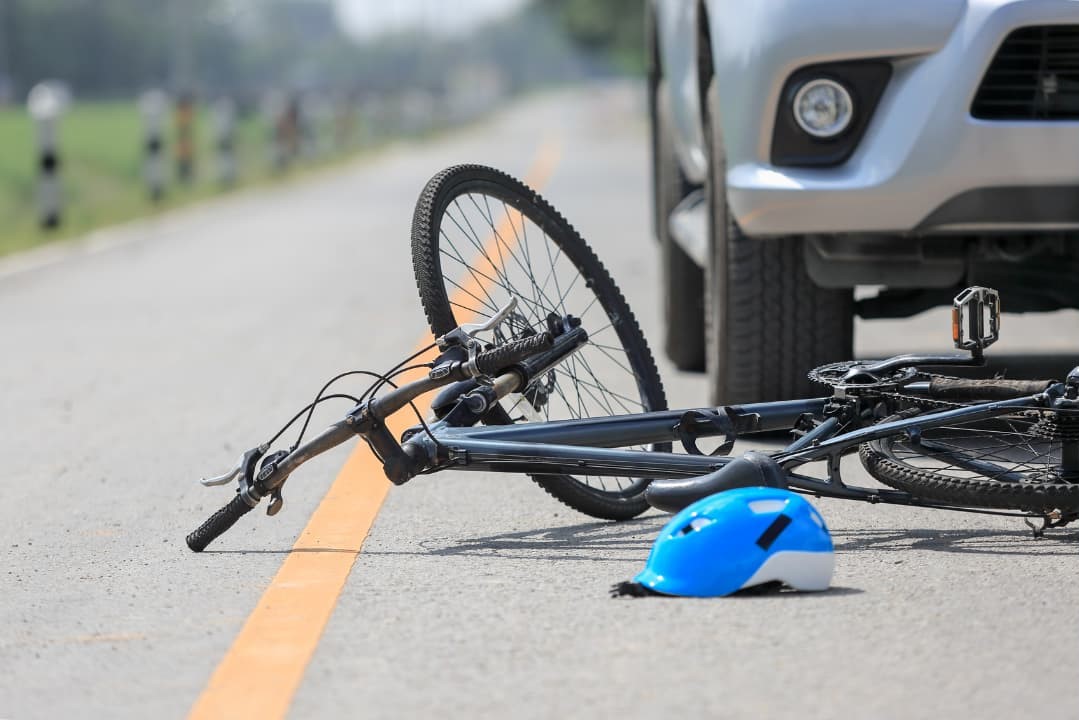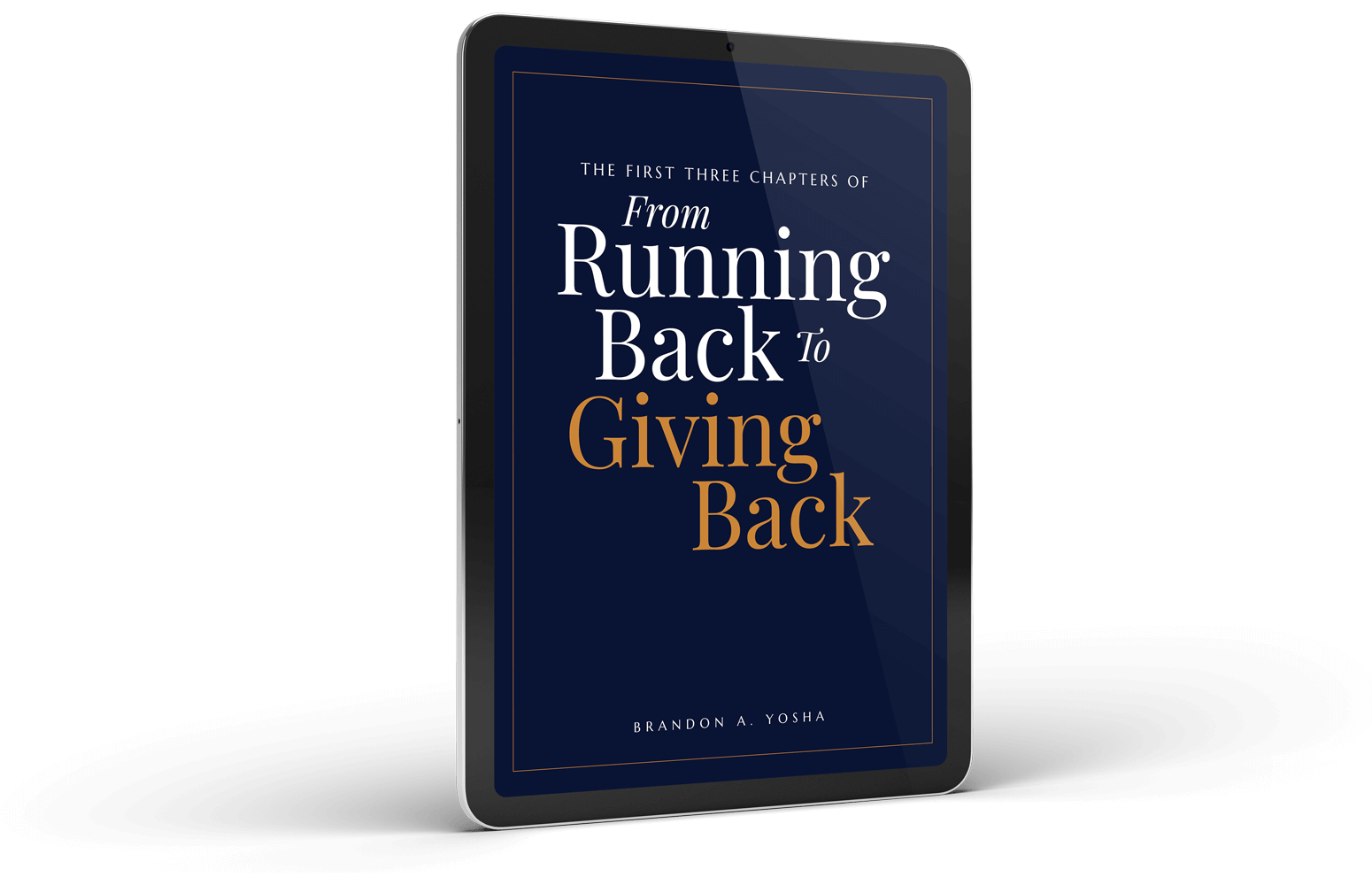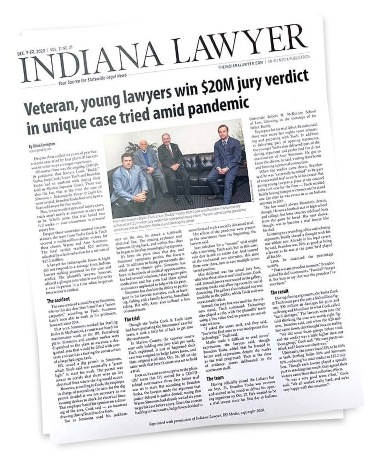Indiana law protects bicycle riders the same as motor vehicle drivers. If you are injured while riding a bike due to another person’s negligence, you may be able to hold them accountable. An Indianapolis bicycle accident attorney could help you hold the wrongdoer accountable and recover compensation for your injuries.
Whether the bicycle accident results from a car driver’s negligence or a bike defect, you have a right to hold the wrongdoer accountable. Let an experienced personal injury attorney in Indianapolis help you hold the defendant responsible for their actions.

Collisions with motor vehicles
Cars and bicycles often share the same road. Unfortunately, this can also lead to car accidents caused by the careless actions of car drivers. A lawsuit involving a car accident is typically brought under a negligence theory.
Car drivers have a duty to all other motorists sharing the roadways to drive lawfully and reasonably. When a driver handles his or her vehicle in an unreasonable or unsafe manner, they have breached their duty of care according to Indiana law. Once the breach occurs, the driver becomes liable for any injuries arising from their negligence.
Establishing a driver’s actions were unreasonable requires proving how a reasonable person acts in similar circumstances. To prove that the driver was responsible for the accident, contact an Indianapolis bicycle accident lawyer.
Bicycle accidents and product defects
When purchasing a new bicycle, you trust that it will perform as expected. Unfortunately, mistakes are made when designing or manufacturing bicycles, resulting in accidents.
Design defect
A design defect occurs when the bicycle design results in an inherent flaw or mistake. As a result of the flaw or mistake, the bicycle is dangerous when used in an expected manner. The risk created by the defect must be foreseeable to the manufacturer at the time of design.
Manufacturing defect
A manufacturing defect occurs in the production stage of the bicycle. Mistakes such as using the incorrect screw or forgetting a part constitute a manufacturing defect and result in a dangerous product. To recover damages for a manufacturing defect, you must be injured while using the bicycle in an expected manner.
Holding a manufacturer liable for a bicycle accident could be difficult, but contacting an Indianapolis bicycle accident attorney may help your chance of success.
Bicycle injuries suffered by a minor
Indiana law does not allow a person under the age of 18 to bring a lawsuit. The law does allow a family member or legal guardian to sue on behalf of the minor. An experienced personal injury attorney in Indianapolis could help bring a lawsuit on behalf of a minor injured in a bicycle accident.
Indiana Code §34-11-6-1 allows minors to wait until their 18th birthday to sue for their injuries. While the statute of limitations is two years from the accident date, an exception exists for minors. Once the minor turns 18, they have until they are 20 to bring a lawsuit for injuries sustained in a bicycle accident.
Bicycle accident injuries we represent
Bicycle accidents can lead to devastating injuries. This is particularly true when a cyclist is struck by the driver of a car or truck. Bicycle accidents not only result in serious injuries from the impact of the motor vehicle, but injuries also occur when a cyclist is thrown from their bike as well. Some of those injuries include:
- Road rash
- Broken arms
- Sprains and strains
- Traumatic brain injuries
- Broken legs
- Lacerations
Serious injuries cause more than physical pain. For cyclists that do not have insurance, an accident could cause significant financial harm as well. From medical expenses to lost wages, the cost could be extreme. The good news is that filing a personal injury lawsuit with the help of an Indianapolis bicycle accident lawyer could help you recover the compensation you need to make themselves financially whole.

How long does it take to recover from a bike accident?
The recovery time after a bicycle accident depends on the severity of your injuries. A broken bone or sprain usually takes about two months to heal. Smaller injuries may take less than that.
If you suffered an injury to your spinal cord, traumatic brain injury, or internal organ damage, it could take you several months or even years to recover. In the worst cases, some bike accident victims are never able to recover.
Recovering from a bad bicycle accident can take months or years of therapy and specialized care. During this time, you might not be able to work, preventing you from paying your medical bills. A personal injury lawsuit may be your best option for getting the money you need.
Can you get PTSD from a bicycle accident?
Yes, you can develop PTSD from a bicycle accident. You can develop post-traumatic stress disorder (PTSD) from any traumatic event that you experience. If your bicycle accident was traumatic for you, you may be reliving the memory over and over. You may feel like you can never get on a bike again.
Psychological problems after a bad bicycle accident aren’t uncommon. It can also lead to depression or anxiety disorders. If this happens, you may have to seek therapy to help you deal with it. You may be able to get compensation for your therapy or counseling sessions as part of a personal injury lawsuit, if you can prove your mental state is tied to your bicycle accident.
Who is usually at fault if a bicycle is involved in an accident?
In many cases, the driver is at fault in a bicycle accident — but not every case. It can be difficult to know who caused the accident after it’s over, so it’s usually a good idea to hire a bicycle accident attorney in Indianapolis to help you with filing insurance claims and filing a lawsuit, if it comes to that.
Both cyclists and motorists have to follow the rules of the road, but motorists have to pay a bit more attention. If you are a cyclist who was hit by a motor vehicle and you were following proper traffic rules, you may be able to file a claim with the driver’s auto insurance to cover your injuries.
Proving fault in a bicycle accident
In order for a cyclist to recover compensation for their injuries, they must prove negligence. If they cannot show the defendant in their injury lawsuit was negligent, they will not be entitled to recover a monetary award.
There are four elements that every plaintiff must prove in order to establish negligence. Failing to establish even one of these elements is fatal to a personal injury claim. The four elements of negligence include the duty of care, breach, causation, and damages.
The duty of care
To be entitled to a monetary award, a cyclist must first show that the defendant owed them a duty of care. These duties do not exist in every situation, and the lack of a duty will absolve a defendant of any damages that occur. This element is typically not at issue in bicycle accident claims, as motorists that share the road with cyclists owe them a duty to drive their vehicles safely.
Breach of the duty of care
After establishing a duty exists, a plaintiff must next show the defendant breached it. A breach could occur in different ways in a bicycle accident lawsuit. For example, a motorist that fails to yield the right of way and strikes a cyclist has breached their duty of care.
Causation
A plaintiff must also establish a causal link between the injuries they suffered in the accident and the defendant’s breach. Without this link, a defendant is not responsible for the cyclist’s injuries. This element exists to ensure that a negligent party is only held responsible for the harm they caused. This prevents them from facing liability for any injuries that occurred outside of the bicycle accident.
Damages
The final element a cyclist must prove in these cases is damages. Even if the other elements are easily established, a cyclist is not entitled to financial compensation if they cannot show they suffered measurable damages.

Bicycle accidents and insurance
Insurance doesn’t work the same way for bicyclists as it does for motorists. Medical expenses and other damages could be covered by the at-fault party’s auto insurance, if you were hit by a car while riding your bike.
The insurance coverage depends on who was at fault, how many parties were involved, and the extent of the injuries or property damage.
Can I file a claim if I get knocked off my bike?
If you get hit by another cyclist, and can prove they were at fault, you may be able to file a claim with the other cyclist’s homeowners or renters insurance. You may also be covered by your health insurance.
If you’re cycling and you get hit by a motor vehicle, the driver’s auto insurance might be able to cover you — that’s only if the driver is the one at fault. If the driver is uninsured, you may have to rely on your health insurance. If you were the one at fault, the driver may be able file with your homeowner’s or renter’s insurance for property damage and injuries.
What type of insurance covers bikes?
Depending on the nature of the accident, any one of the following types of insurance may cover you:
- Homeowners’ or renters’ insurance
- Health insurance
- Auto insurance
If you were the cyclist involved in the accident, you may need to file with your health insurance for your injuries and with your homeowners’ or renters’ insurance for damage to your bike. If you were the driver, your auto insurance might cover the cyclists’ damages if you were at fault.
How much compensation will I get for a bike accident?
The amount of money you’re awarded in a bicycle accident case varies significantly based on your injuries and property damage. Compensation packages can range from $10,000 to over $1 million. Ideally, you should receive enough money to cover the costs of your medical bills and other accident-related expenses.
Types of compensation for bike accidents
Ultimately, cyclists that pursue legal action after an accident seek monetary compensation. While there are several types of compensation available in a bicycle accident lawsuit, they each fall into one of two categories: economic and non-economic damages.
Economic losses
Economic damages are measurable losses that can come with a bicycle accident. Damages are considered “measurable” when your attorney can quantify a specific value for the losses, based on the evidence. They submit documentary evidence like paid receipts or bills to show a jury the exact amount of compensation that is owed.
Examples could include:
- Medical bills: ambulance rides, surgeries, prescription medication, or emergency room visits
- Lost wages: when a cyclist suffers injuries in an accident that prevent them from working, they could miss out on multiple paychecks while they recover
- Repairing or replacing a damaged bike
A personal injury lawsuit could help an injured cyclist pay for these and other expenses. For wages, it could include not only the wages they lost prior to filing suit but also for any future lost wages as well. It’s also possible to recover the cost of repairing a damaged bicycle or even replacing it entirely if it is beyond repair.
Non-economic losses
Not all losses are simple to measure. While it might be impossible to assign a uniform value to these claims, it could be possible to recover compensation for non-quantifiable losses. These are known as non-economic damages.
Non-economic losses are subjective. Some examples are:
- Pain and suffering: Although tied to your injuries and medical bills, pain and suffering compensation is considered non-economic because no two individuals experience pain the same way.
- Emotional trauma: A bike accident can take a mental toll on you, which can affect all areas of your life.
- Loss of enjoyment of life: Sustaining a serious injury, such as paralysis from the waist down, could prevent you from doing things you did prior to the accident that you enjoyed doing.
- Mental anguish: Being fearful of riding a bike again because you have traumatic memories of the event could be considered mental anguish and you may be able to receive compensation for it.
How do you calculate non-economic damages in a bicycle accident lawsuit? Experienced Indianapolis bicycle accident lawyers will know how to, and how to gather evidence to support it.
How do you mentally recover from a bike accident?
After being in a bad bicycle accident, you may feel mentally or emotionally distressed. Some people even develop PTSD. Typically, this only occurs after the accident happens and once the injuries have healed. Mental anguish can leave a person fearful of riding a bicycle again or bring up stressful memories of the traumatic event.
While it might be difficult and take some time, you can mentally recover after a bike accident. You could seek counseling or psychiatric therapy to help you deal with the stress, frustration, and mental anguish you feel after a bicycle accident. You could even try riding a stationary bike indoors to help you feel comfortable riding again, but in a safe and controlled environment.
Some recovery options may end up costing you financially, however. You may have to pay for your counseling sessions or other therapy you decide to do. If it’s related to your accident, you may be able to seek compensation for mental anguish or emotional distress to help you pay for the medical care you need.
Let an Indianapolis bicycle accident lawyer help you recover compensation
Bicycle accident injuries can have a life-changing impact. Hold the defendant responsible for their actions and recover for your injuries. An Indianapolis bicycle accident lawyer could be the difference you need in your case.
Our firm has a team of attorneys ready to help you recover. Schedule a consultation today with an experienced bicycle accident lawyer.







